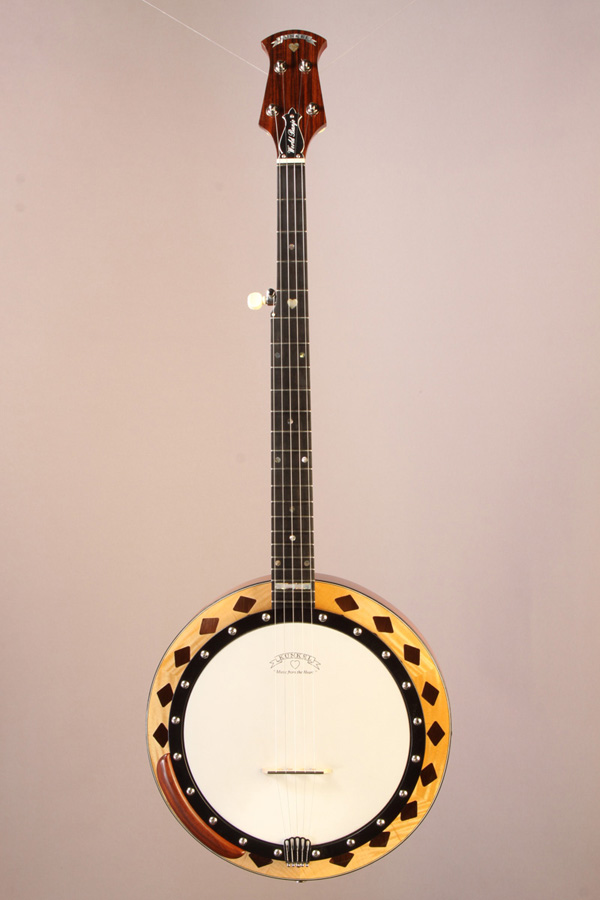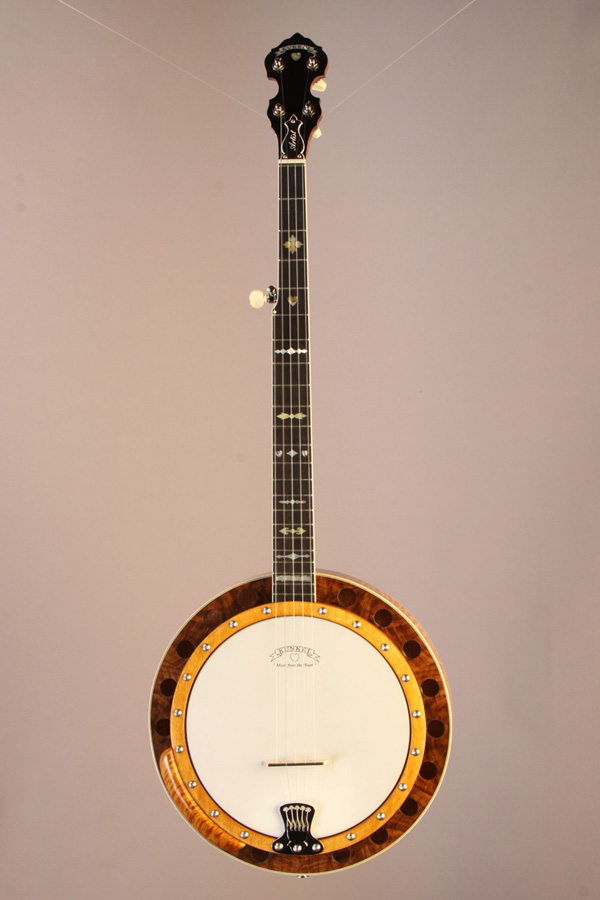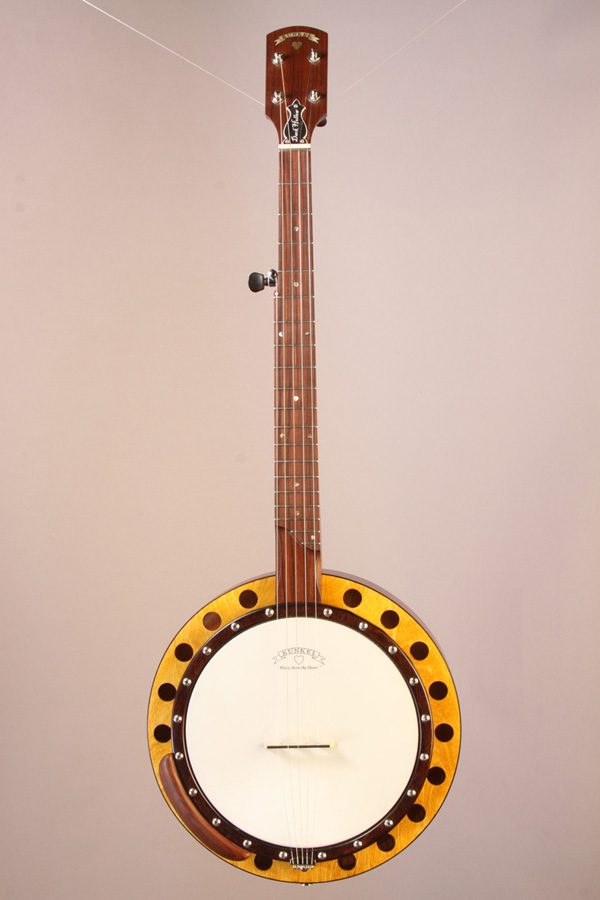Banjos
 Imagine having a banjo with all the volume and clarity of a 12-pound Mastertone style banjo but weighing just over five pounds.
Imagine having a banjo with all the volume and clarity of a 12-pound Mastertone style banjo but weighing just over five pounds.
My all wood banjo is constructed more in the manner of a guitar than a traditional resonator banjo. The neck is attached to a thin outer rim, bolted through a headblock much like a guitar. The hardwood tone ring, flange, and back are all glued and bound into one unit, forming a monolithic tone chamber that is acoustically very efficient.
By eliminating the thick wooden rim, bell bronze tone ring, zinc flange, coordinator rods, separate resonator, and related hardware, the weight and parts count goes way down. In fact, the Kunkel Banjo weighs less than half the weight of a traditional bluegrass banjo.
Because of its unique design, it’s possible to provide a sound port in the rim. This feature not only increases the volume for the player to enjoy, but creates an ambient, radiating tone that fills the room.
I consider it a “world banjo” because it isn’t bound to any genre of music or style of playing. The lack of sharp edges and metal parts makes it more user friendly for guitarists and people who may have wanted to play the banjo but were intimidated by it. My lightweight banjo is the one you’ll want to take along when you travel.
The Kunkel Banjo has become my “go to” banjo for all styles of playing.
Click here to watch Kunkel Banjo video.
What is the Kunkel Banjo?
The Kunkel Banjo is the culmination of my over fifty-year fascination with the five-string banjo.
It is the combination of what every banjo I’ve owned has taught me and many ideas that I have developed over my forty plus year career as a professional luthier. It is a banjo that weighs just over five pounds and yet possesses the volume and resonance of a 12-pound instrument.
The Kunkel Banjo is built more in the manner of a guitar; with a thin outer rim with a head and tail block. It has no heavy inner rim or cast bronze tone ring, but a high-tech plywood flange and a turned wooden tone ring.
It has no coordinator rods. The rigidity of the rim assembly allows me to bolt the neck on in the same manner as a modern guitar.
There are no metal brackets or cold metal tension hoop. These are replaced with a wooden hoop and stainless steel button head allen screws. There is very little metal to polish on my banjo. The handmade tail piece is nickel plated but is also offered in antique brass, copper, chrome, etc. There is a hand carved exotic wood arm rest secured to the wooden tension hoop, making the banjo very comfortable to play without cold metal or sharp edges.
The tuned tone chamber has a sound port that radiates sound to the player’s ear like a monitor.
I hand carve the one-piece neck which has a dual action truss rod.
Pro players have said that “it is fun” to play and that it’s unique warm and woody sound is great for blending in a vocal setting and country music.
It sounds great without the heavy metallic ring that is often not desired.
It sounds great in all styles of playing, from bluegrass three finger picking to mountain claw hammer to finger style without picks. It can dig in and make a statement or be very sweet and sonorous. It does it all beautifully.
The Kunkel Banjo is a new category of banjo and the U.S. Patent Office agreed; awarding it Patent Number 8,816,176 B1.
A Little History
The banjo was a primitive instrument that originated in Africa primarily consisting of a gourd body with an animal skin stretched over it, a stick going through the gourd with gut strings tensioned over the bridge. The slaves who brought it to the new world would hardly recognize how greatly it has developed from those humble beginnings.
In 1831, an early minstrel player, Joel Sweeny, is credited with the addition of the “chanterelle” or shorter fifth string which gives the 5-string banjo its unique character. He most likely observed slave players using their thumbs to play a shorter string to produce a rhythmic pedal note that we would recognize in clawhammer and three finger banjo playing.
Later the gourd was replaced with a bent wood rim, probably the frame of a grain sifter, with a skin head “tacked” over it. The industrial revolution and the American Civil War made screw machines and interchangeable metal parts cheap and abundant, and inventors began to design more sophisticated systems for tightening the head. Plated metal hardware came to the fore.
At this point the banjo could have gone in another direction, but wood technology hadn’t evolved at the same rate as metal.
Banjo makers like Henry C. Dobson were making instruments that were all wood, but because they were limited to hide glue, and high-quality veneer plywoods hadn’t been invented, they were unsuccessful. The instruments relied on a dowel stick to support the string tension because it was inconceivable to build a body strong enough to support without it. Also, the connection between the flange and the outer rim was weak and so, most of the volume and tone were lost.
Boston makers such as Fairbanks and Vega experimented with metal shoe bands and tone rings, adding to the weight. Fancy metal hooks and nuts were heavy and uncomfortable for the player.
The Gibson Mastertone banjo became the standard for bluegrass players. The cast bronze tone ring alone can weigh five pounds. It produces a metallic bell-like tone, which can be too loud and over powering at times and too strong for vocal accompaniment. At around twelve pounds, it can also be too much banjo to shoulder for any length of time.
Examining all these factors and with my extensive woodworking background, I set out to redesign the banjo using techniques and materials that haven’t existed until recently. This, in conjunction with old world joinery and innovated design has produced a new category of banjo; The Kunkel Banjo.
FEATURES
The Body
- The body is a one-piece resonant tone chamber comprised of a thin, steam bent outer rim supported by a quarter sawn mahogany head and tail block.
- A 15mm Baltic birch flange which dovetails into the head and tail block and has four fingers that connect to the outer rim and are supported on spruce pillars glued to the outer rim.
- Threaded inserts are installed in the flange to accept stainless steel tension bolts. The inserts are replaceable in the unlikely event of a problem.
- Mahogany kerfing is glued to the rim to secure the veneered “beauty ring” and the laminated back.
- A sound port is created in the outer rim to deliver greater volume for the player to enjoy.
- A ½” diameter hole is drilled through the tail block to accept an end pin jack for an electronic pick-up. This also acts as a strap button.
- Two holes are drilled to fasten the neck to the body with a 3” and a 1 ½”allen cap screw.
- The back is made up of seven layers of veneer that are laminated into an arched lens shape. The outer veneer is exotic hardwood; mahogany, maple, walnut, etc.
The Tone Ring
The tone ring is made up of eight segments of exotic hardwood that are joined together and turned on a lathe. It is fitted to the body by means of four steel pins and is interchangeable if a different tone ring sound is ever desired. I am currently making them out of Cocobolo, Grenadillo, and Iron Wood, AKA Hornbeam. Many other species will produce excellent tone and experimentation is ongoing.
The Neck
- The neck is hand-carved of 2” thick quarter sawn hardwood; mahogany, maple, walnut, etc.
- A dual-action truss rod is installed to control the neck.
- The neck features a “zero fret.” The nut acts as a string guide only, while the zero fret sets the perfect height of the string and produces an identical tone to the open strings as it does the fretted notes.
- Most of my necks feature a “volute.” This is a sculptural feature that acts as a hand stop at the upper end of the neck shaft and the transition to the head stock. It is widely used on violin family instruments.
The Tension Hoop
The tension hoop is made of eleven ply Baltic birch plywood and is veneered on the outer edge. It is drilled to receive stainless steel button head allen screws
The Arm Rest
The arm rest is hand carved of exotic hardwood; cocobolo, figured maple, figured walnut, etc. It is secured to the tension hoop and offers a very comfortable playing experience.
The Tailpiece
I offer a variety of tail pieces. I use the Fielding tailpiece on the World Banjo model, my two-piece,down tension tail piece on the Artist model, and the traditional No Knot on the Dark Hollow model.






